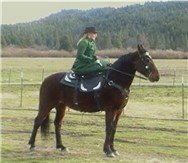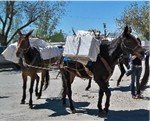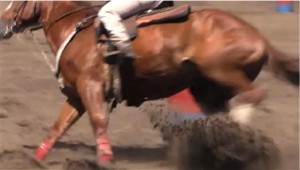Endurance Riding
with
Berit Meyer
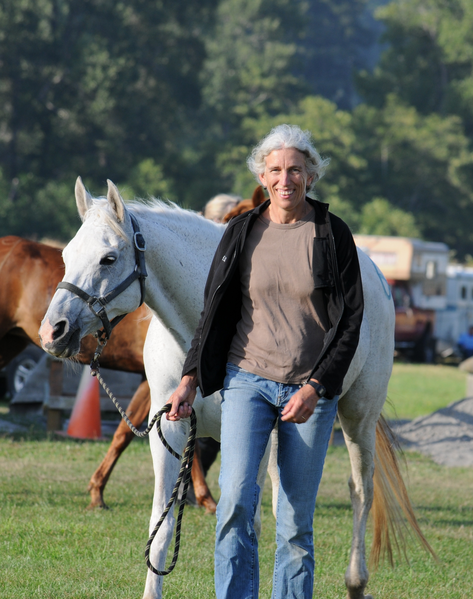 Endurance Rider Berit Meyer with Tezona
Endurance Rider Berit Meyer with TezonaMeet Berit Meyer – Long time horse owner, successful business woman and endurance riding enthusiast. Berit is an active member of Redwood Empire Endurance Riders and among other things, has served as club president.
When she’s not playing with her horses, she’s busy running her business, Ramone’s Bakery with her husband. And let me tell you…they make the most fantastic chocolate raspberry torte…ever! And when she’s not running the bakery, she’s just running. Berit’s also a committed jogger. I caught up with this busy lady to pick her brain about the popular sport of endurance riding.
Berit, thank you so much for talking with us today! How long have you been endurance riding and how did you come to get involved?
I started in 1983, when an old cowboy named Carl Pfieffer, who had heard I'd done a Ride & Tie, asked me to come ride his horses, and maybe I could pair up with his nephew to do another Ride & Tie.
What is Ride & Tie, Berit?
Ride & Tie involves a team of 2 runners, and 1 horse, and you switch off every mile or more, whenever you determine you'd like to switch, and the runners take turns riding, and in between, the horse gets tied to a tree...It's sort of a leap frogging event, and really fun! I did my first one in college, in 1977, at Point Reyes National Park. Since then I've done 7 more...Super fun!
I developed a knee problem, so never did the Ride & Tie, but got the endurance bug when Carl took me to a ride up in Oregon, and I got to do a 25 miler on his horse Starlite. I bought my first endurance horse a year later, an Anglo-Arab, named Sequoia, and thought I'd like to see if I could get a horse in shape on my own!
For those of us that are unfamiliar with endurance, tell us a bit about the sport.
The distances are generally 25, 50, 75 and 100 miles, usually over a course of a combination of single track trails, and dirt or gravel roads. Each of the distances has a cut-off time to compete, and within that time there are several vet checks, and a lunch stop, to get a chance to refuel (both horse and rider!) and have the vet give your horse an examination to determine if your horse is ok to continue.
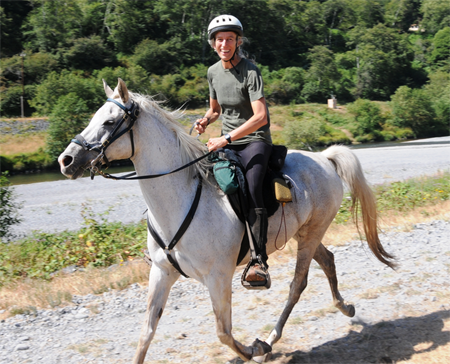 Gotta pass those vet checks!
Gotta pass those vet checks!The vet will look at many criteria to make sure your horse can safely finish. The first one would be pulse, and usually your horse needs to have a rate of 60 beats per minute. If you are going too fast, you will have a longer hold at the check point, because you won't be able to continue until that pulse is met.
The lunch stop is 1 hour, and you will take your saddle off, give food to your horse, and hope it's drinking lots of water by then. The vets also look at hydration, gut sounds, lameness issues, surface wounds, and several other criteria to make sure your horse is doing well.
If you have been conditioning your horse to prepare for the ride, you will be able to smoothly complete, and have a lot of fun while you're at it. I love meeting new folks, having time to chat along the trail, see the backcountry of areas that I never would have been able to, and camping before and after the event.
I understand that it’s a bit of a horse race but not quite, would you explain the difference?
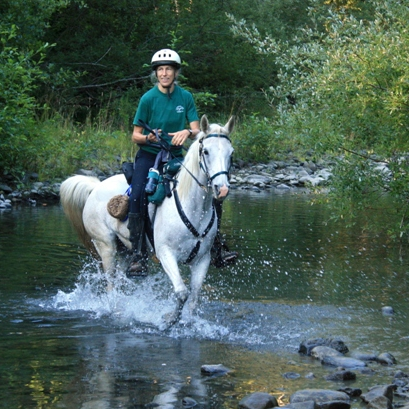 Endurance ride river crossing
Endurance ride river crossingWell, there are riders that are competitive, and you do get the extra recognition if you come in the "top ten", and being first is a thrill! The award that is the most prestigious would be the Best Condition, which means your horse looks the fittest afterwards, and it usually goes to someone on the top 5.
There is a factor of weight that the horse is carrying, the speed it is traveling, and how perky it's attitude and gait is when it's shown before the vet at the completion of the ride.
Also pulse, gut sounds, etc...If a horse is under stress, there will be fewer gurgles heard through the stethoscope, meaning the gut is shutting down to conserve energy for the hard work of the ride. So yes, there are riders who want to be in front, but most of the participants are just out to enjoy the scenery, have a fun day with their friends, and be with their horse for the day!
What kind of training do you do to prepare for a ride?
I try and begin months in advance of my first endurance ride, and start by walking for an hour a couple of days a week. Then I will put some trotting in the mix, and do some hill work... I usually never have time to ride for more than 3 days a week, if I get to 4, I'm really doing well! I will even just do 2 days a week in the beginning...and do an extra day when I can.
I am glad I have access to a beach, so even in the winter I can ride, without having to worry about too much mud. I don't have an arena to ride in, but I know some folks can get some work in that way.
I like to get a couple 3+ hour rides in, and then a 5 hour ride before my first E ride of the season, but this year I only got a slow 3 hour ride in for my longest in the saddle, and my horse did great at her first endurance ride. She does have a good base by now though.
Once the season starts, you will want to give your horse a few weeks off between rides, so there really isn't a lot of riding that needs to take place once you start the season. I am not a top 10 rider though, and my horse is presently low key. There are more rigorous training programs to look at, and competitive riders ride a lot more than I do.
I imagine an unconditioned horse can get into trouble out on the trail. Are there any official measures taken to prevent this sort of thing?
I did mention some of those above. It's no fun to have your horse get in trouble. Sometimes horses get caught up in the moment, and push faster than they are capable of. Horses do like to race, and you think your horse is doing better than it actually is.
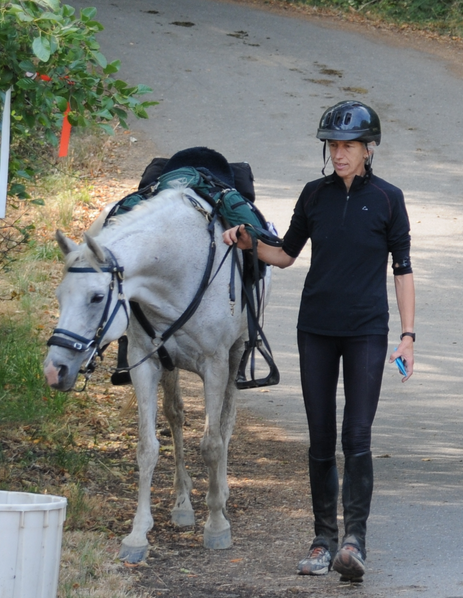 Hydration is key
Hydration is keyAt the vet checks, of which there are usually 3 for a 50 mile ride, and you have 12 hours to finish the distance, the assistants will first check pulse before you even get to see the vet. Splashing water on it's body will help it to cool off and bring the pulse down faster. If the pulse does not come down within half an hour, you will be pulled, and get a trailer ride back to the start/camp.
Sometimes you will need to walk your horse in on foot to a vet check, and this may mean a bunch of miles. Your horse may have stepped on a rock, or lost a shoe (and you don't have an EZ boot) or you think your horse doesn't feel right or cut it's leg...
But the main thing is, there are vets that check your horse before the ride, and are looking at it throughout the day, always asking questions of the rider, who should be tuned in to changes. I would recommend riding very conservatively to begin, and even better, have a buddy to ride with.
That would be reassuring in case you have doubts out on the trail, and you can have a pal to discuss the matter with.
When I think of endurance, I think of Arabian horses. Is that in fact the dominant breed of the sport, or do you see other breeds competing out there as well?
Arabians are definitely the most popular breed in the endurance world. They have a thinner skin, and can dissipate heat more quickly. They are bred for traveling in the heat, and they have a lot of go! I loved my Thoroughbred/Arabian cross, and Mustangs do quite well, as do Morgans, and others, especially if crossed with an Arabian.
What advice would you give to a newcomer interested in endurance riding? Are there ‘short’ endurance rides that a newbie can do just to get a feel for the sport?
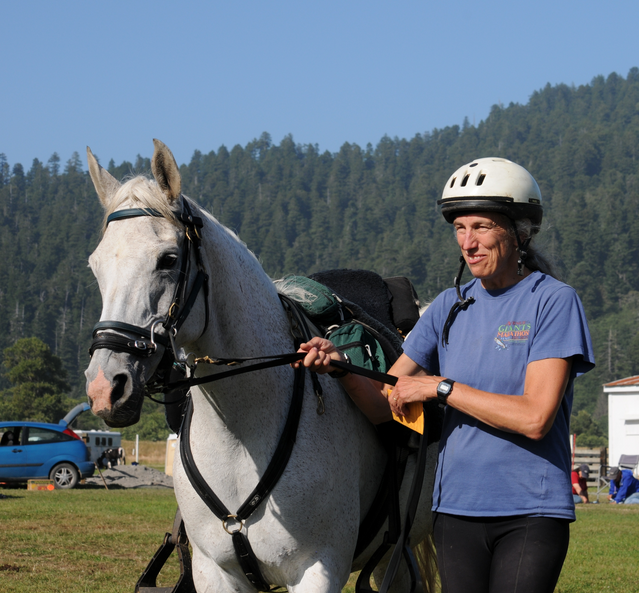
There are shorter introductory rides, 10 miles usually, and it's a great way to get a feel for the sport, and see what a vet check is like. These are often in conjunction with a sanctioned endurance ride, so you'd be able to see what goes on with the horses that are fit.
It's very exciting, and even volunteering at a ride would be much appreciated, as there are always duties that need to be filled. Pulse takers, timers, vet secretaries, water haulers...
There are books out there, and with the internet, lots of info at your fingertips. I have been doing this for 30 years, and still aspire to small goals I want to accomplish in the sport. It's so much fun, and you get to know your horse on a whole different level!
One last question. How is it going for you and your horse this year?
This year was Tezona's best ever, as far as endurance riding goes... Hard to believe, as she is 18 years old.
We passed our 3,000 endurance mile mark, finished our first 100 miles in one day, the Tevis, (the big Granddaddy of Endurance rides.), and had our all time highest mileage in one season. Plus last year we were recognized as a "Decade Team" member, which means we have done 10 years of consecutive Endurance Miles. (They have now decided to have this mean 10 years of endurance, as sometimes, more often than not, there will be 1 or more years, where something will get in the way of not being able to compete for a year).
Wowee that's a lot of miles! Thank you Berit. It's been fun and very informative. Congratulations to the both of you for a successful decade!
Other Horse Talk Interviews:
Home > Horse Talk > Endurance Riding with Berit Meyer
